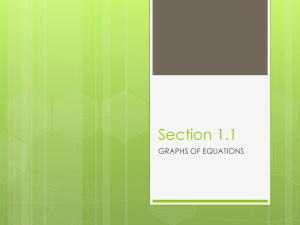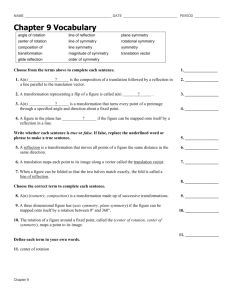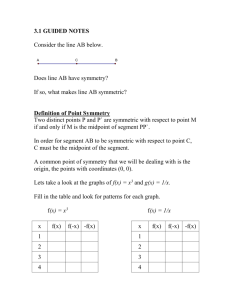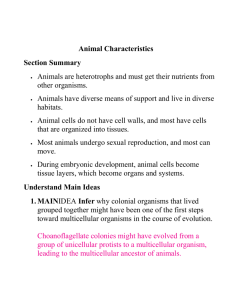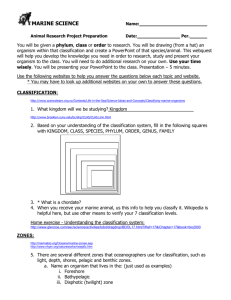Choice of Elements
advertisement
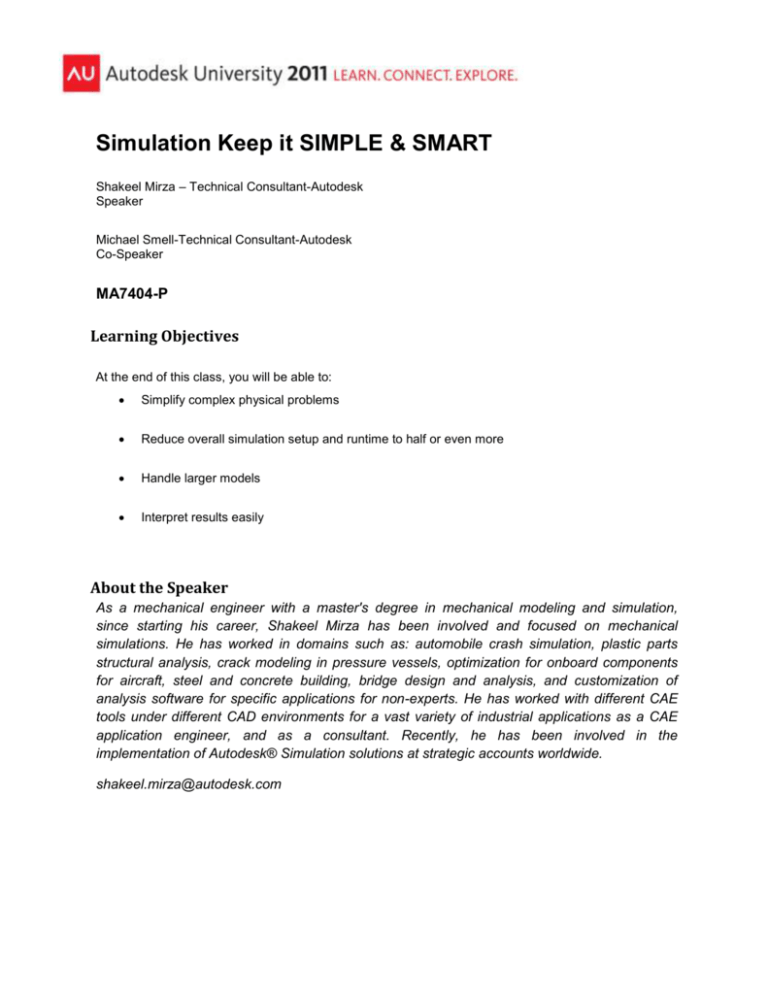
Simulation Keep it SIMPLE & SMART Shakeel Mirza – Technical Consultant-Autodesk Speaker Michael Smell-Technical Consultant-Autodesk Co-Speaker MA7404-P Learning Objectives At the end of this class, you will be able to: Simplify complex physical problems Reduce overall simulation setup and runtime to half or even more Handle larger models Interpret results easily About the Speaker As a mechanical engineer with a master's degree in mechanical modeling and simulation, since starting his career, Shakeel Mirza has been involved and focused on mechanical simulations. He has worked in domains such as: automobile crash simulation, plastic parts structural analysis, crack modeling in pressure vessels, optimization for onboard components for aircraft, steel and concrete building, bridge design and analysis, and customization of analysis software for specific applications for non-experts. He has worked with different CAE tools under different CAD environments for a vast variety of industrial applications as a CAE application engineer, and as a consultant. Recently, he has been involved in the implementation of Autodesk® Simulation solutions at strategic accounts worldwide. shakeel.mirza@autodesk.com Simulation Keep it SIMPLE & SMART Geometric Simplifications: Suppress Unnecessary Parts or Features: From an analysis perspective, unnecessary features or even parts can be suppressed from a model. An unnecessary feature can be a small radius fillet or a hole whose presence will not have a significant impact on the stresses in critical zones. In such cases it’s helpful to suppress those features as this will allow work on a much lighter model. Typical mechanical assemblies consist of parts, fasteners and various constraining parts. Although all parts might not be critical from a design perspective, they still play an important role to join parts together or impose particular motion constraints. Such parts can be suppressed for FEA as long as their role can be modeled by simple representation. For example in case of a bolt, holding together two parts firmly, the bolt can be suppressed and the two parts can be modeled as joined together using contacts or other simplified models. Same holds true for welds, rivets and pins. However if the parts are creating a special state in the model, for example a bolt with significant pretension, it needs to be modeled with more details. Exploit Symmetry: When creating a model for finite element analysis, natural lines of symmetry and antisymmetry can allow you to analyze a structure or system by modeling only a portion of it. This technique can reduce the size of the model (the total number of nodes and elements), which can reduce the analysis run time as well as the demands on computer resources. Required Conditions to Exploit Symmetry in a Model To take advantage of the symmetrical modeling technique, the following conditions for symmetry (or antisymmetry) must exist: the geometry, material properties and boundary conditions are symmetric the loading is symmetric or antisymmetric. It’s required to build a model of the symmetrical portion (half, quarter, eighth, etc.) and apply the appropriate boundary conditions. This consists of isolating the symmetric portion from the complete model. Advantages of a symmetrical/antisymmetrical model include the following: Faster model preprocessing, meshing and post processing A finer mesh of the symmetrical model for greater accuracy can be generated Far less computational resources required (Disk space, memory, processor speed) 2 Simulation Keep it SIMPLE & SMART Planar or Mirror Symmetry Planar or Mirror Symmetry means a model is identical on either side of a dividing line or plane (see Figures 1-3). Along the line or plane of symmetry, boundary conditions must be applied to represent the symmetrical part as follows: Out-of-plane displacement = 0 The two in-plane rotations = 0 Figure 1: Model with a Line of Symmetry Figure 2: Model with a Plane of Symmetry Figure 3: Example of Symmetry for Plate Elements 3 Simulation Keep it SIMPLE & SMART Antisymmetry Antisymmetry means the loading of a model is oppositely balanced on either side of a dividing line or plane (see Figures 4-5). Boundary conditions must be applied along the line of symmetry as follows: 1. Out-of-plane rotation = 0 2. The two in-plane displacements = 0 Figure 4: Antisymmetrical Model . Figure 5: Example of Antisymmetry for Plate Elements Figure below shows an antisymmetrical boundary condition in Autodesk Simulation software. 4 Simulation Keep it SIMPLE & SMART Cyclic symmetry Cyclic symmetry occurs when the geometry, loads, constraints and results of a partial model can be copied around an axis to give the complete model. A typical example is a fan blade or turbine. If the loads on the blades and geometry repeat, only one blade needs to be modeled instead of the entire hub of X blades. See figure below. The result is a smaller analysis which takes less time to analyze. Figure above shows a Cyclic Symmetry Example (the highlighted section, including the load, can be copied 7 times about the axis O to create the full model) In particular, cyclic symmetry forces the radial, tangential, and axial displacements at the nodes on one face (A in Figure) to match the same nodes on the opposite face (B in Figure). When Not to Use Symmetric Models: The evident case were symmetric model are to be avoided is where the model contains a feature that disrupts the symmetry and can create significant unsymmetrical behavior. A hole in one of the fan blades can be considered as a simple example. Apart from that, under certain circumstances, it’s not possible to exploit symmetry even though the model, material, loads and supports might be symmetric. 5 Simulation Keep it SIMPLE & SMART Basically whenever the expected results are non-symmetrical, symmetric models must not be considered. For example in case of a modal analysis of a symmetric model, one can expect very well to see unsymmetrical modes of vibration. These modes will not be captured if a symmetric model is being used. Same holds true for buckling analysis. An axisymmetric analysis of a hollow pipe will give the critical load of buckling of the first axisymmetric mode; while in reality the pipe will buckle at a much lower load in an unsymmetrical mode. Choice of Elements Another very powerful time saving technique is the choice of best suited element for an analysis. This is based upon the primary and secondary variable that is being sought as output from the analysis. 1. 3D-Solid Elements Three dimensional solid elements are the easiest to use and simply discretize a three dimensional geometry (solid part) into smaller finite elements. They don’t require any preparation of model for geometry. They are best suited for massive parts (molded, casted ,forged parts) To capture bending in thin models with solid elements, three elements should be created through the thickness. If this cannot be done for the model and is needed, the model may need to be evaluated using plate elements. 6 Simulation Keep it SIMPLE & SMART 2. 2D Elements: Certain specific cases can be represented in 2D. 2D elements can be used if the expected behavior is symmetric in one of the 3D dimensions. Three main types of 2D elements are: 1. Plane Stress 2. Plane Strain 3. Axisymmetric The first three types are not only geometrically 2D (that is without thickness explicitly modeled) but should strictly lie in a 2D plane. Plate and Shell elements can be drawn in 2D but can assume any shape in 3D space. 2D elements are three- or four-node elements that must be formulated in the YZ plane. They are used to model and analyze objects such as bearings or seals, or structures such as dams. These elements are formulated in the YZ plane and have only two degrees-of-freedom defined: the Y translation and the Z translation. Temperature-dependent orthotropic material properties can be defined and incompatible displacement modes can be included. When to Use 2D Elements: To model a cross section of a part. Plane stress geometry type: No stress in the X direction (through the thickness). Strain in the X direction is allowable (for example, thin plate under an axial load). Plane strain geometry type: No strain in the X direction (through the thickness). Stress in the X direction is allowable (for example, large dam). Axisymmetric geometry type: Model is axisymmetric about the Z axis and exists only in the positive Y quadrant of the YZ plane. 7 Simulation Keep it SIMPLE & SMART 3. Shell Elements: These elements are used to model thin plate/shell type structures in 3D space. As a general rule they represent the mid-surface of a thin solid without any thickness modeled as part of the geometry but defined as an element attribute to model the correct stiffness. The huge advantage of shells is that the user doesn’t need to worry about the recommended “three elements in the thickness” for thin solids. Typical Shell Elements Each shell element node has 5 degrees of freedom (DOF) - three translations and two rotations. The translational DOF are in the global Cartesian coordinate system. The rotations are about two orthogonal axes on the shell surface defined at each node. The rotational boundary condition restraints and applied moments also refer to this nodal rotational system. 8 Simulation Keep it SIMPLE & SMART 4. 1D or Line Elements: These types of elements are used to model thin slender members like beams, trusses, cables etc. They essentially consist of a line with attributes such as cross-section properties. They are used to represent structures of length much greater than the width or depth (approximately 8-10 times). Beam and truss elements are the most common types from 1D element family among others. Beam elements are two-node members which allow arbitrary orientation in the 3D (threedimensional) X, Y, Z space. An additional node (K-node) is required to define the element orientation. The beam transmits moments, torque and forces and is a general six (6) degree of freedom (DOF) element (three global translation and rotational components at each end of the member). Truss Elements on the other hand are similar in construction as beams but without the ability to transmit moments, they can be considered as beams that are pinned together hence the name truss. Trusses, by definition, cannot have rotational DOFs. Truss elements are two-node members which allow arbitrary orientation in the XYZ coordinate system. The truss transmits axial force only and, in general, is a three degree-of-freedom (DOF) element. They are used to model structures such as towers, bridges, and buildings. The three-dimensional (3D) truss element is assumed to have a constant cross-sectional area which is defined as an element attribute 9


